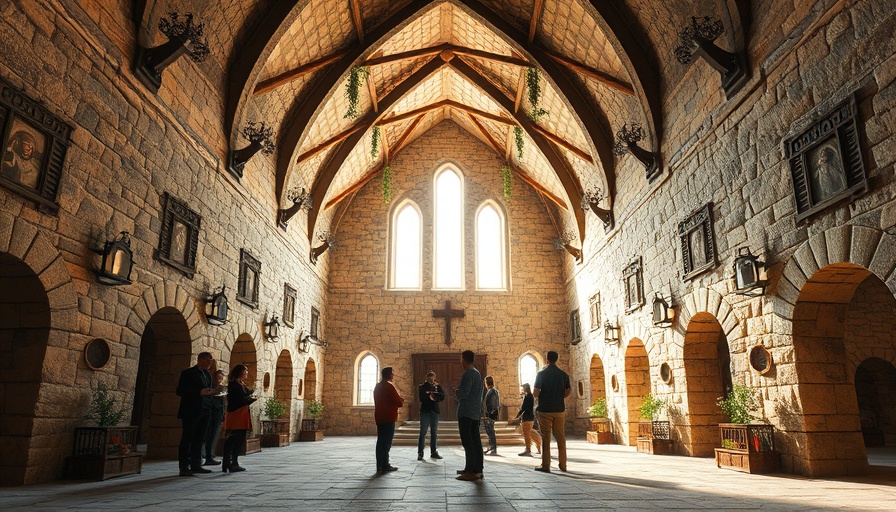
The Open Chapel: A New Sanctuary for Reflection
In the quaint village of Hillershausen, Germany, a remarkable architectural project has taken shape, presenting both a beautiful and functional space. The Open Chapel, designed by Christoph Hesse Architects, stands as a testament to community collaboration, sustainability, and the integration of natural elements.
Embracing Nature with Mandorla Design
The chapel is artfully encircled by twelve sandstone pillars arranged in a distinctive mandorla shape, which translates to 'almond' in Italian—a form often used in religious art to depict sacredness. This design is not merely aesthetic; it’s crafted to invite the surrounding natural elements to flow in and interact with those gathered inside. According to architect Christopher Hesse, the gaps between the columns allow wind, sunlight, and even sounds to permeate through, creating a serene atmosphere that fosters connection and introspection.
A Community Effort: Built by the People
One of the most profound aspects of the Open Chapel's creation is its connection to the local community. Residents of Hillershausen actively participated in its development under an initiative known as Open Mind Places, which aims to engage rural populations in creating scenic spaces for communion and contemplation. Through workshops and collaborations, locals contributed their thoughts, labor, and resources, ensuring that the chapel reflects their collective hopes and values.
Functional Yet Aesthetic: The Features of Open Chapel
Made up of 3,960 sandstone blocks, the pillars create hollow niches for wooden benches, offering both functionality and comfort. Above, a mandorla-shaped steel roof adorned with plants provides an organic connection to nature, enhancing the chapel's openness while simultaneously offering shelter. The interplay of these elements—a wooden candleholder suspended from the roof and the natural illumination from concealed lights—creates an inviting atmosphere, especially at night when the chapel is visibly illuminated from the neighboring village.
The Importance of Sustainability in Design
All materials chosen for the Open Chapel prioritize sustainability, availability, and durability. Local resources have been creatively utilized—from recycled wood chips sourced from a Christmas market for the flooring to oak wood provided by local carpenters for benches and beams. This thoughtful selection of materials not only reduces environmental impact but also strengthens the community's ties to the chapel.
A Space for Everyone: Inclusivity in Design
Open Chapel is designed to be a welcoming space for individuals of all backgrounds, irrespective of their faith or beliefs. This spirit of inclusivity arises from the philosophy behind its formation; it aims to be a sanctuary not just for worship but also for reflection and community interaction. The chapel serves as a backdrop for shared experiences, allowing visitors to engage with each other and with nature, fostering dialogue and connection.
Reflections on Wellbeing in Workspaces
As digital nomads, finding spaces that nurture creativity and productivity is essential. The Open Chapel exemplifies how spaces can encourage mental clarity and foster a sense of community, which translates well into the realm of remote working environments. Elements such as natural light, openness, and materials that promote comfort are all aspects that can be adopted in personal workspace design.
Looking Ahead: The Future of Community Spaces
The Open Chapel stands as a model for future architectural projects aimed at community engagement. It illustrates how spaces can be harmoniously crafted with input from local residents while prioritizing ecological sustainability. With rural areas seeking revitalization, spaces like the Open Chapel may inspire similar initiatives worldwide, blending architectural beauty with functional community engagement.
As we approach a future increasingly centered on environmental consideration and social connectivity, the Open Chapel offers a blueprint for achieving harmony in design—allowing us to create spaces not just for worship, but for coming together as a community. For those interested in enhancing their own working environments, consider integrating these principles of nature, functionality, and community involvement into your workspace.
Call to Action: Explore how you can enhance your workspace to be more reflective and community-oriented. Engage in local initiatives to create spaces that support both productivity and well-being.
 Add Row
Add Row  Add
Add 




Write A Comment